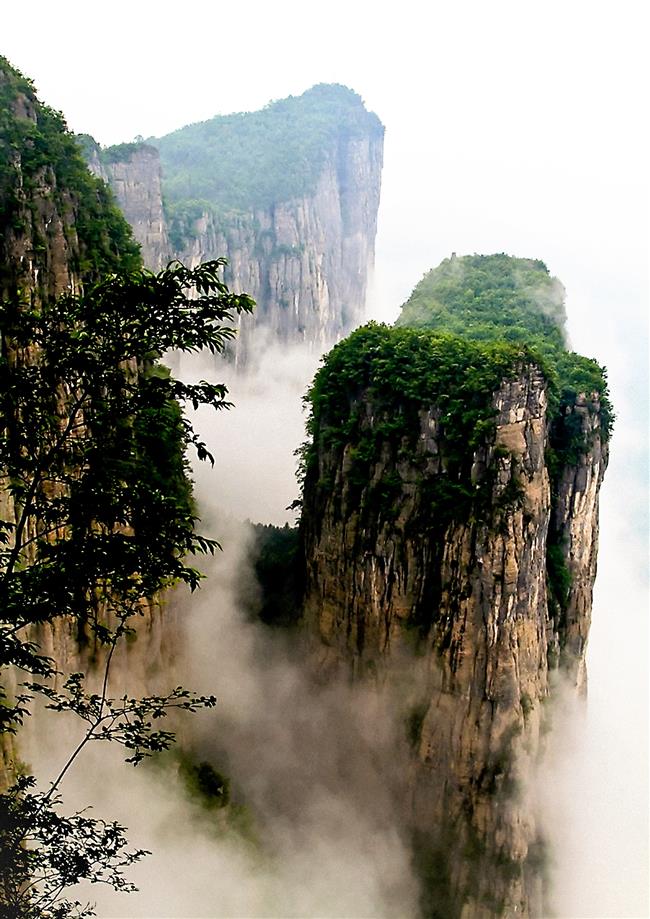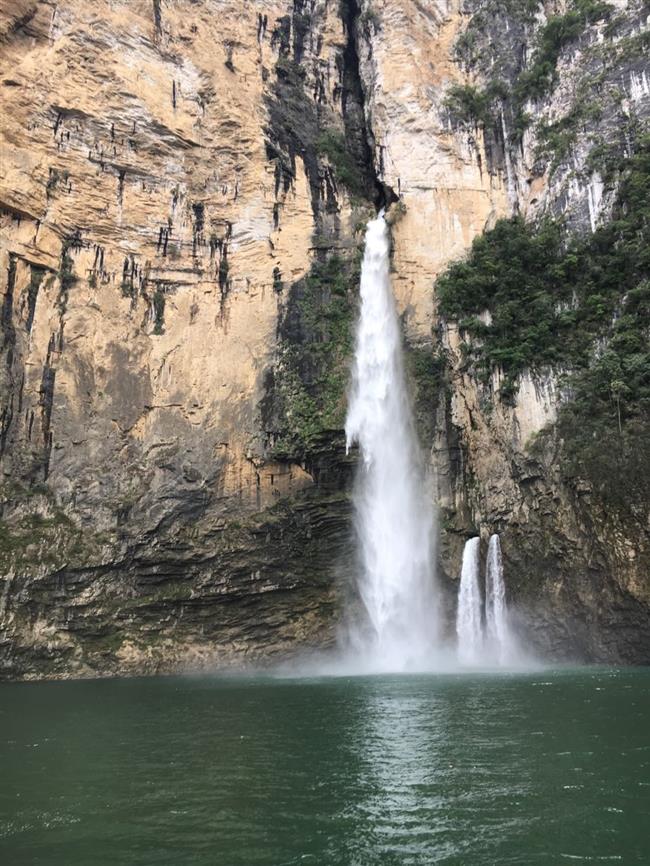Immersed in the landscape of Chinese ancient legends

Enshi Grand Canyon is said to be often misty, especially after rain.
As the riverboat heads toward two waterfalls cascading from steep canyon walls, the idyllic scene in Hubei Province seems to conjure up inspiration for a Chinese legend. There is a sense that we are not in China, or anywhere known, and that the landscape has been created by divine powers.
In a country overrun with commercial tourism, it’s a wonder that the Enshi Tujia and Miao Autonomous Prefecture in the southwestern mountains of Hubei has remained so remote and rural. Enshi, the seat of the prefecture, has a history dating back to the Spring and Autumn Period (770-476 BC).
But modernization is fast transforming the area, and with it a considerable increase of tourism. The city airport in Enshi has been upgraded, the Huyu Highway was built connecting Shanghai and Chongqing, and high-speed rail service has come to the area. The prefecture’s transport infrastructure includes the Sidu River Bridge, the world’s highest span.
“After the completion of the Huyu Highway eight years ago, the paving of local roadways came three years after, and the following year came the renovation of many once decrepit homes,” said my guide Sun Tianqi. “It used to take hours on a mountain road to reach one of the nearby scenic sites, but now it can take a matter of minutes. The kind of tourism you are experiencing today would have been impossible 10 years ago.”
Along with tourism has come an overhaul of the local economy through the central government’s campaign of jingzhun fupin, or “precision poverty alleviation,” which has provided subsidies and assured purchasing quotas for the region’s tobacco and tea industries. In a local soil rich in selenium, wild purple mountain bananas grow while it is also common to see tangerines, grapefruit and grapes being cultivated.

Wild mountain bananas

Bowls are supposed to be smashed after visitors finish their plum wine at Nu’er Cheng, or “City of Girls,”
The ethnic Miao and Tujia comprise the majority of the region’s minorities. Both groups are well-known for their colorful dresses, independent languages and unique cultural traditions.
A Miao woman selling jewelry who declined to be identified said that the Tujia and Miao had no need to speak Mandarin 20 years ago.
“But with the recent influx of outside businesses and people, the need to communicate and interact has forced us to speak Mandarin,” she said. “Fewer people nowadays can speak their ethnic languages.”
Guide Sun said many old customs have waned in the last two decades. Take the Tujia wedding tradition known as kujia or “crying of marriage” for example. The bride often needs to cry for days before she is to be “exchanged” for a dowry received from the groom’s family. The tears may be more symbolic than actual. At any rate, the old ritual is largely being replaced by Western-style wedding customs.
Fortunately for tourism, the charm of Miao and Tujia traditional songs and dances seems to have thus far escaped from being discarded. At a recently built tourist attraction called Nu’er Cheng, or “City of Girls,” traditional dances are performed and visitors can drink plum wine in the Tujia manner known as shuaiwanjiu, or “breaking a bowl of wine.”
After finishing the wine, one smashes his or her empty bowl to the ground to express emotion and relieve stress. The cacophony of dozens of bowls being smashed amid drinking, eating and toasting create an entrancing sensation not easily forgotten.
While the ethnic people of the region are certainly a drawing card for visitors, so is the scenery.
Here are three popular sites, each about a two-hour drive from Enshi.

Flying Dragon Cave is an amazing karst structure.
Flying Dragon Cave
Tenglong Dong, or Flying Dragon Cave, is an awesome karst structure. Its mouth is 74 meters high and 64 meters wide, and the cave penetrates some 50 kilometers into a mountain, ranking as the world’s seventh-longest cave and the longest within Asia.
To access the cave requires crossing a swift river that leads underground into the heart of the mountain.
Ancient people believed that monsters dwelled in its darkness, inspiring local legends and an aura of spirituality. Traditional Tujia and Miao songs and dances are performed in the cave.
Grand canyon
Enshi Grand Canyon provides spectacular views, unless you are unlucky enough to visit on a foggy day.
Often compared to the Grand Canyon in the United States, this 108-kilometer-long canyon is stunning. Its steep cliff faces and the infamously erect yizhuxiang, or “stick of incense,” stands just under 150 meters high at less than 4 meters in diameter at certain points.
Peak and gorges
The Yellow Crane Peak towers over the Wild Three Gorges, offering an exceptional view of the Qingjiang River and surrounding mountains and countryside.
A 20-minute drive down the mountain to the river wends through multiple small valleys in which farmers’ houses and their crops permeate throughout what little level ground exists. It is easy to imagine how different dialects could develop in each separate valley.
I was traveling here in October when harvested maize was piled in the open air to dry. The landscape was dotted with ancestral tombs among both maize stocks and grapes vines.
On the shore of the Qingjiang River, a ferry tour service is available for a 90-minute trip to the waterfalls.
The towering walls and falls of the Qingjing River Canyon must have enchanted and captured journeymen’s admiration over thousands of years.These kinds of enchantment continue to enthrall those who live alongside the mountains and who come for their beauty.
If you go:
It takes about three hours by air from Shanghai to Enshi. High-speed train between the two places costs about nine and a half hours.

A waterfall in the Wild Three Gorges















